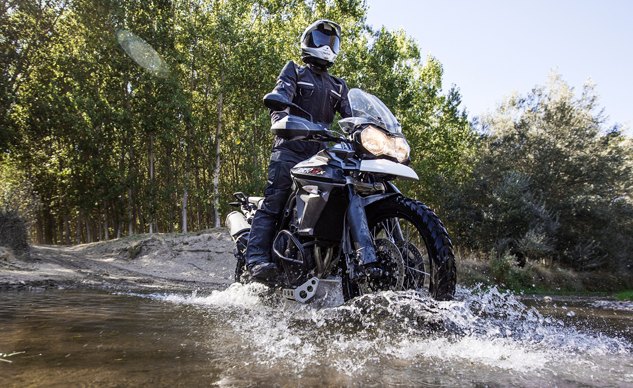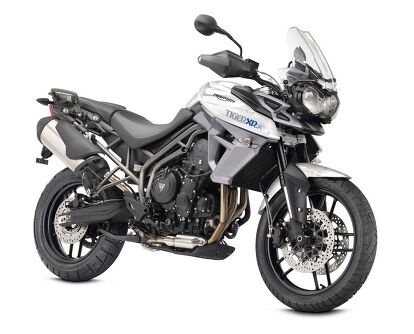2014 EICMA: 2015 Triumph Tiger 800 XR/XRx, XC/XCx Preview

Four Triumph Tiger 800 models to handle just about any terrain
Triumph unveiled four new Tiger 800 variants today at EICMA 2014 – the XR/XRx, and the XC/XCx. The former favor a more road-going bias with occasional light-duty off-roading, while the latter flip the script and prefer dirt to pavement. As standard fitment, all four models receive traction control, ABS and ride-by-wire throttle. XRx and XCx models come fitted with cruise control (the first in its segment) and three riding modes which enable the rider to control throttle response, traction control and switchable ABS. Further, XC models come equipped with WP suspension for greater off-road ability (Showa components adorn XR models). In the engine bay, all four Tigers are powered by the existing 800cc Triple. However, Triumph claim a 17% increase in fuel economy over last year, jumping to 65 mpg vs. 55 mpg.
The lowercase “x” versions indicate the more premium versions of their respective models, which provide greater adjustability of the electronics. On non-x models, ABS and traction control can only be turned on or off, while the x bikes have the ability to customize settings via the different ride modes. For example, choosing the off-road setting disables rear wheel ABS for better stopping ability off the pavement, while TC allows greater slip in the rear compared to Road mode, which off-road riders obviously prefer.
Four different throttle maps are available for XRx and XCx models: Rain, Road, Sport and Off-Road. Each successive step up allows an increased level of throttle response, while the Off-Road setting “provides the optimal throttle response to face dirt tracks and unpaved terrains,” says Triumph.
In addition to being able to tune ABS, power output and traction control via the maps, the Tiger 800 line features three ride modes – road, off-road and Programmable Ride Mode. Of those, the last is most interesting. It allows the rider to select their chosen settings for ABS, Traction Control, and a choice of four throttle maps independently. As an added safety measure, should the rider select a mode that requires ABS or Traction Control to be disabled, then the rider must come to a stop and push the mode button and these features will be deactivated.
From a suspension POV, XR models are fitted with Showa components, calibrated mainly towards road use. The front suspension is a 43 mm Showa USD fork, now anodised black. The rear suspension includes a Showa mono-shock which is preload adjustable. For the XC, however, a WP 43mm USD fork, with rebound and compression damping is easily adjustable through dedicated clickers on the fork tops. The rear suspension unit is a WP mono shock adjustable for preload and rebound damping and has a dedicated dirt protector for the RSU body.
Wheels further differentiate the XR and XC models, with the former fitted with light-weight cast aluminum wheels, 17-inches in diameter at the rear, 19-inches in front, measuring 4.25 and 2.5 inches in width respectively. Meanwhile, XC models feature spoked wheels for superior durability on rough terrain: 17-inch diameter at the rear with 4.25 inches in width and off-road oriented 21-inch diameter at the front with 2.5 inches in width.
The new Tiger 800 has been given a new look with a new radiator shroud and tank side panels that have sharp lines and taut surfaces. The new bodywork gives the bike a more prone, dynamic stance but the styling isn’t all just about cosmetic gain, the Tiger’s fuel tank styling also ducts hot air from the engine away from the rider’s legs. Alongside the adjustable rider seat height and handlebar position the bike gets a large-for-the-class 5-gallon fuel tank (which Triumph claims is good for well over 200 miles a tank), a quick-adjust headlight angle lever for 2-up riding, an auxiliary power socket near the ignition switch and an aluminum sump guard as standard on all models. Both bikes also feature adjustable seats and handlebars to fit a wide variety of rider shapes and sizes, and on the XRx and XCx the screen is adjustable without tools with the x models also receiving newly-designed hand guards to increase rider protection.
Pricing has not yet been announced, though Triumph says bikes will be available by Spring 2015. For more pictures, see the gallery below.

Troy's been riding motorcycles and writing about them since 2006, getting his start at Rider Magazine. From there, he moved to Sport Rider Magazine before finally landing at Motorcycle.com in 2011. A lifelong gearhead who didn't fully immerse himself in motorcycles until his teenage years, Troy's interests have always been in technology, performance, and going fast. Naturally, racing was the perfect avenue to combine all three. Troy has been racing nearly as long as he's been riding and has competed at the AMA national level. He's also won multiple club races throughout the country, culminating in a Utah Sport Bike Association championship in 2011. He has been invited as a guest instructor for the Yamaha Champions Riding School, and when he's not out riding, he's either wrenching on bikes or watching MotoGP.
More by Troy Siahaan



















































































































































Comments
Join the conversation
On the road version, how much disadvantage is it to have a 19" front wheel vs. a 17" like Multistrada, FJ-09, S1000XR, etc.?
WAIT
is that tiger painted Neon Blue? :D